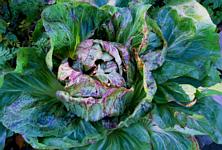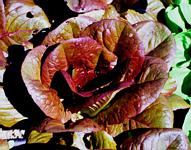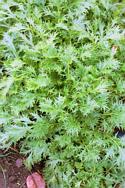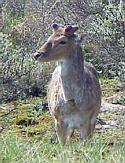Organic Website July is winter gardening month and we at Terra Viva
Winter |
 |  |
The zucchini is starting
to produce and summer salads are now a staple of evening
dinners. It’s tempting at this time of the year to put
your feet up, relax and enjoy the bounty of your hard
work. Yet by November, I’m often left wishing I had
put in a little more effort in July so that I could
harvest fresh food through the wintertime.
July is the ideal month
to start a winter garden. A couple of weeks seeding
and transplanting will result in a kitchen garden that
will produce well into the springtime.
The first step
is deciding what to grow. No need to restrict yourself
to cabbage and Brussels sprouts, fall & winter gardening
can include a variety of lovely edibles:
| Vegetable Type | Recommended Varieties | Time to plant |
| Arugula | all types | July-early Sept |
| Beets | Greenleaf, Winterkeeper | early-mid July |
| Broad Beans | Aquadulce, Windsor | Oct-Nov |
| Cabbage | January King, Tundra | July-mid Aug |
| Carrots | Scarlet Nantes, Autumn King | early-mid July |
| Cauliflower | Armado series, White Rock | mid July |
| Cilantro | all types | July-August |
| Collards | all types | mid July |
| Corn Salad | all types | August-mid Sept |
| Fennel | any bulbing type | early-mid July |
| Garlic | all types | Sept-Oct |
| Giant Red Mustard | all types | August-October |
| Kale | all types | early-mid July |
| Kohlrabi | all types | mid July- early August |
| Mizuna | all types | July-August |
| Overwintering Onions | Walla Walla, Buffalo | mid August |
| Pac Choi | all types | August-September |
| Parsnips | all types | early July |
| Peas | early maturing types | early July |
| Radicchio | all types | July-early August |
| Radish | all types | Sept-October |
| Rutabagas | all types | early July |
| Scallions | all types | July-early August |
| Spinach | Bloomsdale, Tyee | July-August |
| Sprouting broccoli | Green, Purple or White | early July |
| Tatsoi | all types | August-September |
| Turnips | all types | July-August |
| Winter Lettuce | Winter Density, Rouge D’hiver | July-August |
The next step is
to find room in the garden. Although my squash plants
are filling in every inch of their bed, I can usually
find space where my spring veggies used to reside. Often
enough, there’s now room since the lettuce and early
spring greens are all harvested. If it’s still too early
to pull out your plants, you find a small patch in the
garden and start a nursery bed. I enjoy putting all
my seedlings close together like this so that I can
keep an eye out on watering and pest problems. The other
option is to start seeds indoors and transplant them
later. If I know I won’t be around to water during the
day, I try to start seedlings indoors. I do get much
better germination rates and it does save quite a bit
of space.

they usually don’t need any special care until about
September. As the nights begin to cool, draping some
of the less hardy plants like the winter lettuce and
cilantro with a floating row cover protects them from
light frosts. On the coast and in mild winter areas,
a floating row cover is enough to protect seedlings
from mild frosts, up to about 30 F (-2 C). In colder
areas, a plastic cloche or a cold-frame can be used
to keep these vegetables cropping.
One thing to keep in mind
about growing under plastic is that plants will require
extra watering since they won’t receive any rainfall
moisture.
Once plants like Kale
& cabbage are hit by a good frost, you’ll notice
a remarkable difference in the taste. Most winter vegetables
use sugar as a natural anti-freeze. As temperatures
become colder, they fill their cells with sugar to prevent
water in their systems from crystallizing. It’s another
added bonus to growing a winter garden!

Hamir is an agronomist and President of Terra Viva
Organics. When she’s not planting peas or picking zucchini,
she answers questions about organic gardening at: advice@tvorganics.com. You
can also read her gardening articles on Vegetable Gardening
at http://www.suite101.com/
Attracting
Butterflies to Your Garden
by Susan
Ward
The main reason, I think, that so many gardeners are gardening
organically now is simply for the pleasure of it. To be
able to pick ripe fruit right off the tree or harvest
vegetables and eat them without worrying about scrubbing
all the poison off them first is a pleasure that only
organic gardeners enjoy. And whether you’re working or
just sitting and relaxing in your organic garden, you
can delight in sharing the space you’ve created with birds
and insects. The organic gardener is surrounded by trills
of birdsong and rewarded by dazzling displays of jeweled
spiderwebs and butterflies.
Butterflies are a magical presence that I certainly wouldn’t
want to do without, and only a pesticide-free garden
can provide a habitat that welcomes them. Even organically
acceptable pesticides such as rotenone, pyrethrin or
BT (Bacillus thuringiensis, a biological control), kill
butterflies and their larvae. Using techniques such
as handpicking and water sprays to remove pests from
plants instead and tolerating some holes in the leaves
of your plants is a small price to pay for such lavish
beauty. Vegetables can be protected by using floating
row covers.
If you want to attract
even more butterflies to your garden, you’ll want to
ensure that your garden meets their needs. Just like
people, butterflies need warmth, shelter, food, and
a suitable place to raise their families. An ideal habitat
for butterflies is sunny, sheltered, and has a good
variety of plants that will provide nectar and places
to lay eggs.
Providing Shelter
Pick the sunniest spot
in your yard for your butterfly garden; butterflies
need sun to warm up after cooler, overnight temperatures.
As butterflies need protection from wind, the location
should be as sheltered as possible; an area with windbreaks
such as hedges, groups of shrubs, walls, or fences is
ideal. You can also create a windbreak by using a trellis
covered with a vine. Pipevine or hops are especially
fast growers; honeysuckle or clematis are lovely choices.
When butterflies aren’t
searching for food or mates, they love to bask in the
sun; put some flat stones in your garden for sunbathing
spots.
Water is also essential
for butterflies. Birdbaths and open water are not good
sources; they prefer shallow, muddy puddles. Making
a “puddle” that will attract butterflies is easy; just
dig a small, shallow basin, line it with plastic, and
cover it with sandy soil and gravel. Damp soil or sand
also provides butterflies with the minerals they need;
that’s why you sometimes see small flocks of butterflies
gathered around a puddle after a rain.
Providing Food
Most butterflies feed
on nectar, although some also feed on rotting fruit.
The flowers that butterflies like have flat pads, umbels,
cones or spikes and flower heads composed of tiny flowerlets;
feeding on flowers like these is a big energy-saver
as they don’t have to move around so much to feed. Perennials
such as yarrow ( Achillea spp.), bee balm (Monarda spp.),
coneflower (Echinacea spp.), black-eyed Susans (Rudbeckia
hirta) and, of course, butterfly weed (Asclepias tuberosa)
are butterfly favorites. A great many annuals, such
as Ageratum, cosmos, marigolds, nasturtiums, heliotrope
and sunflowers are also excellent sources of nectar.
Herbs are butterfly favorites, both as nectar and larval
food sources. Chives, catnip, lavender, thyme and mint
are all good choices. Planting in blocks of color, rather
than putting in a few individual plants will make it
much easier for butterflies to find their food.
![]() Adult butterflies ready
Adult butterflies ready
to lay eggs are attracted by plants that will feed their
developing young. Many of the plants that are on butterfly-attracting
lists are actually leaf-sources of food for caterpillars.
Each species of butterfly has its own preferred host
plants; the female butterflies search for particular
plants on which to lay their eggs. When you see a butterfly
flitting from plant to plant, briefly landing on a leaf
here and a leaf there, it’s actually tasting the leaf
through sensors in its feet! If you want to attract
more Black Swallowtails, for instance, plant fennel,
dill and parsley, their preferred host-plants; to attract
more Monarchs, plant milkweeds.
Many host plants are trees
such as willows, birches and poplars that may already
be growing in your yard or neighbourhood. Others are
wildflowers such as Queen Anne’s Lace, goldenrod and
nettles. The key to creating a butterfly habitat is
diversity; the more variety of plants you have, the
more butterflies and other insects will be attracted
to your garden.
One of the great advantages
of organic gardening is the feeling such a garden creates.
When you’re working in an ‘organic’ garden, listening
to the happy drone of bees or chitterings of birdsong,
or seeing butterflies dancing around you, you feel at
one with nature and yourself.
Sources
Beaurain, Bill (2000).
Flowers and plants that attract butterflies [online].
Available: http://www.thegardenhelper.com/Butterflies.htm
(May 16, 2000).
Boyd, Gillian. (1997).
Gardening for butterflies [online]. Available: http://www.achilles.net/~ofnc/htbutter.htm
(May 16, 2000).
Lindgren, Dale T., Spomer,
Stephen M. and Greving, Amy. (1996). Nebguide: Butterfly
Gardening [online]. Available: http://www.ianr.unl.edu/pubs/horticulture/g1183.htm
(May 16, 2000).
Stell, Elizabeth. (1995).
Rodale’s successful organic gardening: landscaping with
perennials. Emmaus, PA: Rodale Press.
Susan Ward is a
freelance writer living in Comox, B.C. who has a passion
for gardening. She is the Suite101 Editor for Gardening
in B.C. and writes for magazines such as BackHome.
Designing
Deer Deterrents
by Rebecca
Green
Deer are just about everywhere.
As the human population has moved into wooded areas,
problems with the native deer eating your garden are
becoming more and more prevalent. If you are an animal
lover who is striving to have a garden and live harmoniously
with nature, do not despair. There are numerous humane
methods and organic products available to protect landscape
plants from deer browsing (i.e., deer eating your plants).
The most effective methods are described below.
Design deer resistance
into your landscaping
The most effective means
of managing a deer problem is to use plants deer dislike.
While it may seem like deer will eat just about anything,
this really isn’t true. Deer have strong likes and dislikes.
They also seem to know which plants are poisonous to
them. Unfortunately, many of the plants deer like to
eat have become some of the most common landscape plants.
However, there are dozens of readily available plants
that deer will almost never eat, many of which are more
beautiful and interesting than the more widely used
staples deer find to be so tasty.
Add natural deterrents
If you have some mature
plants that are all of the sudden being devoured by
deer, or if you long for one or two specimens of a plant
deer think of as candy, deer deterrents are possibly
just what you need. While they may not be practical
to use on every plant in your garden, they are very
effective and relatively easy to use on a few select
specimens. Deer will almost always stay away from plants
that offend two or more of their senses. As such, if
a plant not only tastes bad, but smells bad too deer
will stay away from it and the general area it is planted
in. The deer resistant gardener can us this to his or
her advantage.
Some of the most effective
and natural deer deterrents are: hot pepper wax, garlic
oil, predator urine and fragrant soaps. Hot pepper wax
is possibly the most effective deterrent available that
works on the sense of taste. Deer hate spicy foods!
Combined with a deterrent that offends the sense of
smell, hot pepper wax will render your plants almost
deer proof. Garlic oil, predator urine and fragrant
soaps are all highly effective companions to hot pepper
wax. When deer smell the urine of their natural predator,
the coyote, they literally run for their lives. If a
brave deer decides he or she needs a quick bite to eat
before they start running they will think again once
they bite into a plant covered in hot pepper wax. A
deer would have to be on the verge of starvation to
eat a plant covered in hot pepper wax, when the scent
of his or her enemy is nearby and the food smells like
soap or garlic. It just doesn’t get worse than this
for deer.
Add a physical barrier
Deer netting can be used
in combination with sturdy wooden stakes to create a
fence around large plantings or can be wrapped around
individual plants. In addition, deer hate to walk on
netting. As such, it may be secured to the ground to
deter deer from entering garden beds.
Please remember, if deer
are starving they will take extraordinary efforts to
get to and eat your plants. As such, during extremely
bad conditions, such as drought and/or a severe winter,
the effectiveness of any deer deterrent or barrier will
be less than optimal.
Rebecca Green is
the Horticulturist and Founder of My Deer Garden (www.mydeergarden.com). My Deer Garden is a web site
dedicated to helping homeowners understand their deer
problem (called deer browsing). We offer some free garden
plans, a plant database, gardening tips and the option
to order a custom garden design just for you (developed
with you interactively over the Internet). We specialize
in the use of plants that deer generally don’t eat.
Additionally we sell a number of products to help prevent
deer from eating your garden.
